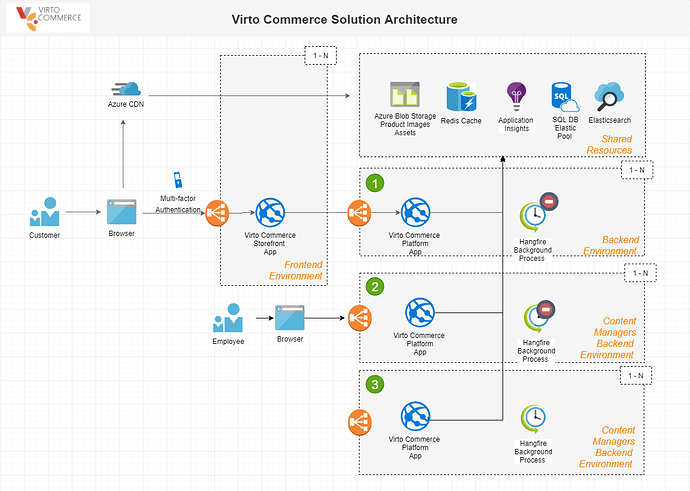Overview
Virto Commerce is a scalable e-commerce solution and designed to build large and complex digital commerce solutions for B2B, B2C or B2B2C business, marketplaces and derived SaaS commerce platforms.
This topic shows the scalability of Virto Commerce Solutions from Smal to Extra Large and helps you choose the right Azure services and price plans.
Architecture
Scalability
This section describes how to scale solution based on Virto Commerce platform and Virto Commerce Storefront Kit.
S: Small
The small environment is good for simple projects, proof of concept, etc.
Key elements:
- 1x Storefront Instance
- 1x Backend Instance
M: Medium
Ready for production and scalability. You can go live with MVP.
Key elements:
- Multiple Storefront Instances
- Multiple Backend Instances
- Redis Cache as Distributed Cache Storage
L: Large
Good for the complex solution and provides ability use benefits of modern Azure service and Virto Commerce.
Key elements:
- SQL Database Elastic Pool (Split modules by different DB: Cart, Order, Catalog, Customers, etc.)
- AzureSearch or Elasticsearch cluster
XL: Extra Large
You can decrease resource utilization and cost by splitting admin by functional elements. Minimize performance degradations from different processes (Ex: Background Jobs to Storefront and Content Managers).
Note: The environment is very close to multiple regions solutions and helps to achieve high availability and high performance.
- VC backend environment for Storefront App (no Background Jobs)
- VC backend environment for Content Managers (no Background Jobs)
- VC backend environment for Background Jobs (focus on high CPU utilization)
Sizing and Cost calculator
This section helps you to calculate the cost are required resources.
Sizing Model
This data based on best practices and feedback from multiple custom e-commerce solutions. The actual result can depend on custom implementation, data and configuration.
| Size | Frontend Requests/sec | Cart Changes peak/sec | Orders per day |
|---|---|---|---|
| S | 10 | 1 | 200 |
| M | 100 | 5 | 1500 |
| L | 300 | 50 | 15000 |
| XL |
| Size | Azure Web Site Price Plane | Frontend Azure Web Site Instance Count | Backend Azure Web Site Instance Count | Azure SQL Price Plane | Azure SQL Count | Azure Virtual Machine (Elastic Search) | ES Cluster |
|---|---|---|---|---|---|---|---|
| S | S2 | 1 | 1 | S2 | 50 DTU | A2 | No |
| M | S2 | 2 | 2 | S3 | 100 DTU | A3 | Yes |
| L | S3 | 3 | 5 | P1 | Several DB /Elastic Pool | A4 | Yes |
| XL | ? | ? | ? | P2 | Several DB /Elastic Pool | A4 | Yes |
Benchmark
Actual benchmark:
Azure Price Calculator
You configure and estimate the costs for Azure products in Azure Price Calculator.
How to improve security
There are several general approaches to improve the security of the application:
- Add Azure Application Gateway
- Add Azure Web Application Firewall before App Web Services.
- Use HTTPS connections
- Limit direct access to services.
How to improve performance
There are several general approaches to achieving high availability and improve performance:
- Increase count of instances with a load balancer (included in Azure)
- Use several databases: one for static content (catalog, etc.), second for dynamic content (customers, shopping carts, orders)
- Use Azure SQL Database Elastic pool Manage multiple databases with elastic pools - Azure SQL Database | Microsoft Docs
- For XL applications, recommend using Azure Premium plans, isolated environment and look towards Azure Cosmos DB



